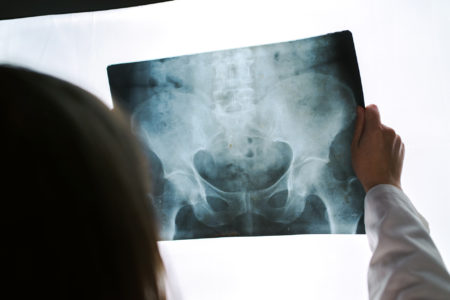
Developmental dysplasia of the hip (DDH) is a condition in which the socket of the hip is too shallow, therefore, the thigh bone (femur), does not fit properly which leads to instability and even dislocation of the hip. Hip dysplasia is often present from birth. However, it can occasionally develop during the first year of life as a child’s body is in a critical developmental stage.
Signs and Symptoms
Early detection is important for successful management of DDH. If you notice any of the following in your infant, it is important to bring it up with their pediatrician:
- Clicking or popping hips: While many normally developing infants have hips that click or pop, it is still important to bring this up with your provider.
- Difficulty spreading legs with diaper changes: With hip dysplasia, some muscles of the hip can become very tight to compensate for the instability at the hip. tiffness with spreading the legs apart can be a sign of DDH.
- Gait abnormalities: Early walkers and toddlers commonly have gait patterns that are odd when compared to older children or adults. However, if you notice that your toddler walks with a limp, it is important to mention it to your pediatrician.
- Uneven skin folds: Nothing is cuter than a little chunky baby with adorable fat rolls. However, if you notice that those sweet little rolls are not quite even on your little ones knees and rear, make sure to have the doctor take a look.
Screening and Detection
It is standard for every newborn to be screened for hip dysplasia at birth. It is not uncommon for a newborn to have a dislocated hip at birth and for it to be completely resolved by a two week check-up. After the newborn assessment, it is standard for all babies to be screened for hip dysplasia during each well child visit the first year of life. Have you ever notice your pediatrician bending and turning your babies legs? They are performing a couple of different provocative tests to check for instability at the hip.
If the pediatrician suspects your baby has hip dysplasia, they will likely order diagnostic imaging to visualize the hip. If your baby is under six months old, a diagnostic ultrasound is the best choice for imaging as the bones of the hip are not ossified enough to be visible by x-ray. After six months, x-rays are a highly reliable tool for diagnosing hip dysplasia.
Treatment
Depending on the age of the child at the time of diagnosis and the severity of the dislocation, treatments can range from bracing and casting to surgical intervention.
- Pavlik Harness: The Pavlik harness is used when hip dysplasia is caught as a newborn up to approximately six months of age. It braces the hip into the correct alignment in the joint socket.
- Spica Cast: A spica cast is typically used on babies older than six months of age. A spica cast is a lower body cast that works to keep the hip aligned correctly in the joint. The length of time a child would need a spica cast varies.
- Surgical Intervention: Unfortunately, in children who are diagnosed late or who have not had success with conservative treatments, surgery is often required. The good news is that outcomes are very good following surgery.
A diagnosis of hip dysplasia can be very overwhelming for a parent. On a positive note, there are many resources available to parents and treatment options have a high success rate. Most children who have DDH can go on to live a full, active life without limitations following intervention.





